外文文献翻译智慧城市技术基础及应用
智慧城市建设(中英文对照)

In the respect ofUrban Traffic
, Chengdu established the application subsystems including traffic incident detection, traffic CCTV, traffic guidance, ramp control, lane instructions, signal control, traffic flow collection at important crossroads so as to improve traffic operation efficiency.The bus operation management and information service systems based on GSP dispatch have been built for providing bus information services for citizens through 1,300 electronic bus-stop boards, public transport service systems and APPs, thereby improving bus service quality and shortening the travel time.
(二)城市运行更加高效
2.More Efficient City Operation
食品药品安全方面,建成肉类蔬菜流通追溯系统,覆盖全市肉类、蔬菜溯源点位11259个,实现了肉菜产品从屠宰、批发、零售到餐桌全程信息化监管,提高了市民对食品安全的满意度。建成中药材质量溯源系统,在10家中药材种养殖基地、荷花池中药材市场所有商户、20家中药饮片生产企业、40家中药材经营企业、19家医院和50家药店进行试点,实现中药材从种植到零售药店、医疗机构的流通追踪溯源,保障了药品安全。
智慧城市英语作文案例
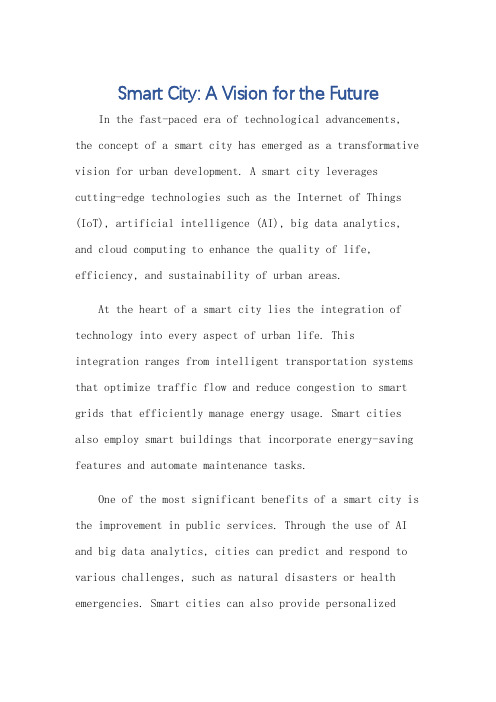
Smart City: A Vision for the FutureIn the fast-paced era of technological advancements, the concept of a smart city has emerged as a transformative vision for urban development. A smart city leveragescutting-edge technologies such as the Internet of Things (IoT), artificial intelligence (AI), big data analytics, and cloud computing to enhance the quality of life, efficiency, and sustainability of urban areas.At the heart of a smart city lies the integration of technology into every aspect of urban life. Thisintegration ranges from intelligent transportation systems that optimize traffic flow and reduce congestion to smart grids that efficiently manage energy usage. Smart cities also employ smart buildings that incorporate energy-saving features and automate maintenance tasks.One of the most significant benefits of a smart city is the improvement in public services. Through the use of AI and big data analytics, cities can predict and respond to various challenges, such as natural disasters or health emergencies. Smart cities can also provide personalizedservices to citizens, such as tailored healthcare plans or education programs based on individual needs.Moreover, smart cities contribute significantly to environmental sustainability. By efficiently managing resources like water and energy, they help reduce waste and carbon emissions. Additionally, the use of renewable energy sources and green building practices further enhance the city's environmental credentials.However, the implementation of smart cities faces several challenges. One major hurdle is the significant investment required in infrastructure and technology. Additionally, there are concerns about data privacy and security, as smart cities generate vast amounts of personal data that need to be protected.Despite these challenges, the benefits of a smart city far outweigh the costs. By leveraging technology, smart cities can create a more connected, responsive, and sustainable urban environment. This not only enhances the quality of life for citizens but also contributes to the overall growth and prosperity of the city.In conclusion, the smart city represents a promising future for urban development. As technology continues to evolve, we can expect to see more cities adopting smart solutions to address the challenges of urbanization. By doing so, we can create safer, healthier, and moreefficient cities that are well-prepared for the future.**智慧城市:未来的愿景**在科技飞速发展的时代,智慧城市的概念作为城市发展的变革性愿景应运而生。
关于智慧化城市的英语作文
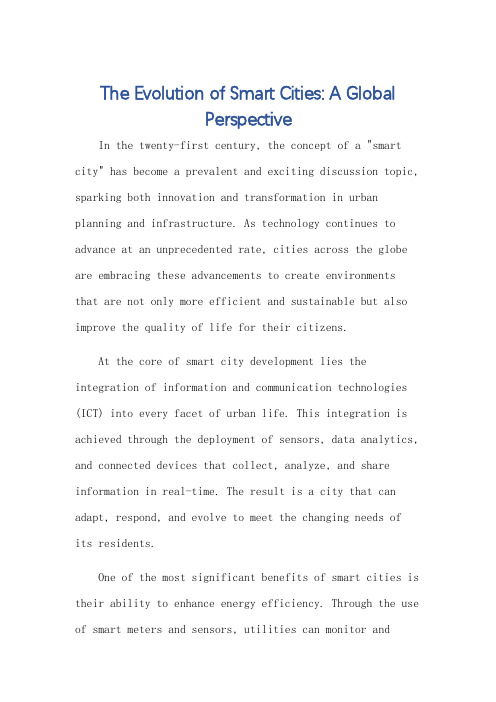
The Evolution of Smart Cities: A GlobalPerspectiveIn the twenty-first century, the concept of a "smart city" has become a prevalent and exciting discussion topic, sparking both innovation and transformation in urban planning and infrastructure. As technology continues to advance at an unprecedented rate, cities across the globe are embracing these advancements to create environmentsthat are not only more efficient and sustainable but also improve the quality of life for their citizens.At the core of smart city development lies the integration of information and communication technologies (ICT) into every facet of urban life. This integration is achieved through the deployment of sensors, data analytics, and connected devices that collect, analyze, and share information in real-time. The result is a city that can adapt, respond, and evolve to meet the changing needs ofits residents.One of the most significant benefits of smart cities is their ability to enhance energy efficiency. Through the use of smart meters and sensors, utilities can monitor andmanage energy use more effectively, reducing waste and costs while promoting sustainability. Additionally, smart grid systems can predict and balance supply and demand, preventing power outages and ensuring a reliable energy supply.In terms of transportation, smart cities are revolutionizing the way people get around. With the help of GPS technology, real-time data, and connected vehicles, traffic flow can be optimized, reducing congestion and improving travel times. Autonomous vehicles and ride-sharing services are also becoming increasingly common, further revolutionizing the transportation landscape.Smart cities are also improving public safety through the use of advanced surveillance systems, emergency response systems, and predictive analytics. These technologies help authorities to identify and respond to threats more quickly and effectively, keeping citizens safe and secure.Moreover, smart cities are fostering economic growth by creating a more favorable environment for businesses and innovation. By providing access to data and resources,smart cities are enabling companies to be more competitive and innovative, driving economic prosperity and job creation.However, while the benefits of smart cities are numerous, their implementation also poses challenges. The integration of technology requires significant investment in infrastructure and human capital. Additionally, issues of data privacy and security must be addressed to ensure that personal information is protected.Despite these challenges, the future of smart cities looks bright. As technology continues to advance and become more accessible, we can expect to see even more cities embrace smart technology, creating environments that are safer, more efficient, and more sustainable.**智慧城市的演变:全球视角**在二十一世纪,智慧城市的概念已成为一个普遍且令人兴奋的话题,引发了城市规划和基础设施方面的创新和变革。
ChatGPT在智能交通和智慧城市领域的应用和前景(英文中文双语版优质文档)
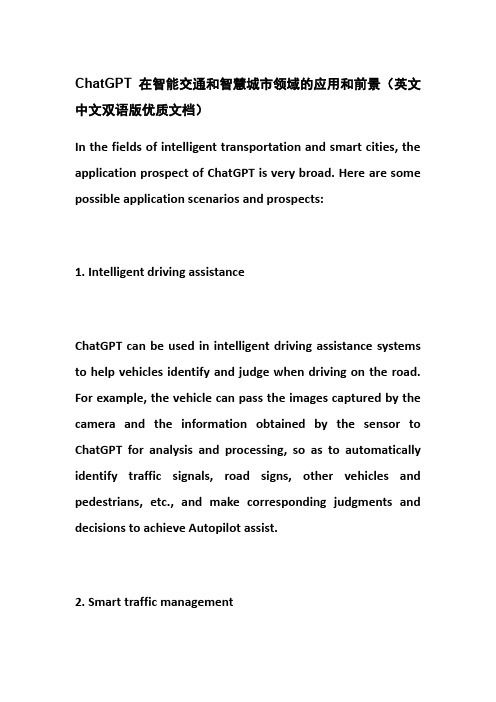
ChatGPT在智能交通和智慧城市领域的应用和前景(英文中文双语版优质文档)In the fields of intelligent transportation and smart cities, the application prospect of ChatGPT is very broad. Here are some possible application scenarios and prospects:1. Intelligent driving assistanceChatGPT can be used in intelligent driving assistance systems to help vehicles identify and judge when driving on the road. For example, the vehicle can pass the images captured by the camera and the information obtained by the sensor to ChatGPT for analysis and processing, so as to automatically identify traffic signals, road signs, other vehicles and pedestrians, etc., and make corresponding judgments and decisions to achieve Autopilot assist.2. Smart traffic managementChatGPT can be used in intelligent traffic management to help traffic management departments optimize traffic flow and reduce congestion by analyzing and processing traffic data. For example, ChatGPT can analyze data such as traffic flow, vehicle speed, and congestion, and propose corresponding traffic optimization strategies, such as adjusting traffic light time, traffic restriction measures, etc., so as to reduce traffic congestion and improve traffic efficiency.3. Smart parking managementChatGPT can be used in smart parking management to help car owners quickly find parking spaces and provide convenient parking services. For example, car owners can tell ChatGPT where and when they need to park through the mobile APP, and ChatGPT will recommend the optimal parking location and route based on real-time parking space information and road conditions, and provide online payment and reservation services, thereby improving parking efficiency and convenience sex.4. Intelligent urban public transportationChatGPT can be used in the intelligentization of urban public transportation to help public transportation management departments improve bus operation efficiency and service quality. For example, ChatGPT can analyze bus real-time location, traffic flow, congestion and other data, and propose corresponding optimization strategies such as bus route adjustment and vehicle scheduling, thereby reducing congestion and improving bus operation efficiency. At the same time, ChatGPT can also provide passengers with intelligent bus services, such as real-time bus information query, recommending the best transfer plan, etc., to improve passengers' travel experience and satisfaction.5. Smart city managementChatGPT can be used in smart city management to help city management departments optimize city planning and services by analyzing and processing city data. For example, ChatGPT can analyze urban traffic, environment, energy and other data, and propose corresponding urban planning and policy recommendations, such as optimizing urban traffic road network, promoting renewable energy, etc., so as to improve the sustainability and quality of life of the city.In short, the application prospects of intelligent transportation and smart cities are very broad. As one of the representatives of artificial intelligence technology, ChatGPT can play an important role in these fields. In the future, with the continuous development of technology and the continuous expansion of application scenarios, the application prospects of ChatGPT will be broader and more diverse.在智能交通和智慧城市领域,ChatGPT的应用前景非常广阔。
智慧化城市英语作文
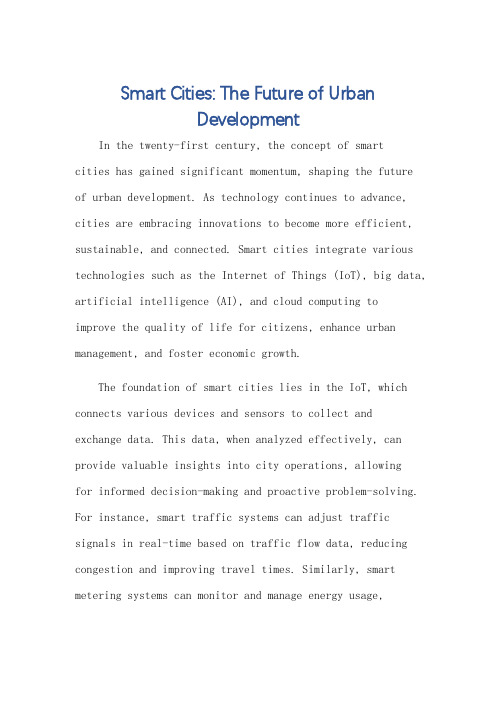
Smart Cities: The Future of UrbanDevelopmentIn the twenty-first century, the concept of smartcities has gained significant momentum, shaping the futureof urban development. As technology continues to advance, cities are embracing innovations to become more efficient, sustainable, and connected. Smart cities integrate various technologies such as the Internet of Things (IoT), big data, artificial intelligence (AI), and cloud computing toimprove the quality of life for citizens, enhance urban management, and foster economic growth.The foundation of smart cities lies in the IoT, which connects various devices and sensors to collect and exchange data. This data, when analyzed effectively, can provide valuable insights into city operations, allowingfor informed decision-making and proactive problem-solving. For instance, smart traffic systems can adjust traffic signals in real-time based on traffic flow data, reducing congestion and improving travel times. Similarly, smart metering systems can monitor and manage energy usage,enabling more efficient resource allocation and cost savings.Artificial intelligence (AI) plays a crucial role in smart cities by processing and analyzing the vast amounts of data generated by the IoT. AI algorithms can predict patterns and trends, enabling proactive responses to potential issues. For instance, AI-powered predictive maintenance systems can identify potential failures in infrastructure such as bridges or roads, allowing for timely repairs and preventing disasters.Cloud computing provides the infrastructure for smart cities, enabling secure storage and access to data from anywhere. This allows for collaboration and coordination among different city departments and agencies, improving the efficiency of urban management. Cloud-based platforms also enable citizens to access city services and information seamlessly, enhancing their engagement with the city.Sustainability is a core aspect of smart city development. Smart cities aim to reduce environmental impacts by promoting renewable energy sources, energy-efficient buildings, and sustainable transportation systems. For instance, smart grids can integrate renewable energy sources such as solar and wind power, balancing supply and demand to reduce waste and emissions.The development of smart cities also fosters economic growth. By improving infrastructure, enhancing theefficiency of city services, and attracting innovative businesses and talents, smart cities create a favorable environment for business development and job creation. This, in turn, generates revenue and taxes for the city, enabling further investments in smart city initiatives.In conclusion, smart cities represent the future of urban development. By integrating technologies such as the IoT, AI, and cloud computing, smart cities are improvingthe quality of life for citizens, enhancing urban management, and fostering economic growth. As technology continues to advance, we can expect smart cities to become more intelligent, sustainable, and connected, shaping the urban landscape of the twenty-first century.**智慧城市:城市发展的未来**在二十一世纪,智慧城市的概念已经获得了巨大的动力,塑造了城市发展的未来。
物联网外文文献翻译

物联网外文文献翻译
物联网是一个由许多设备彼此连接而形成的网络,这些设备可以是智能手机、传感器、汽车等。
物联网允许设备之间相互通信和交换数据,从而实现更智能、更高效和更安全的生活。
在物联网领域,一些外文文献对于我们的研究和研究非常有帮助。
以下是一些常见的物联网外文文献:
- "A Survey on Internet of Things From Industrial Market Perspective":这篇论文介绍了物联网的概念、应用和市场现状,并分析了物联网在未来的趋势。
- "Big Data Analytics for IoT-Based Smart Environments: A Survey":文章描述了如何使用大数据分析来处理物联网设备所产生的数据,并探讨了这种技术如何应用于智能环境中。
- "A Review of Smart Cities Based on the Internet of Things Concept":这篇综述了物联网在智慧城市中的应用,并对物联网在智慧城市化中的挑战和机遇进行了讨论。
通过阅读这些文献,我们可以更深入地了解物联网的应用、市场和发展趋势,并且了解如何将物联网技术应用到实际生活中。
人工智能在智慧城市建设中的应用研究(英文中文双语版优质文档)
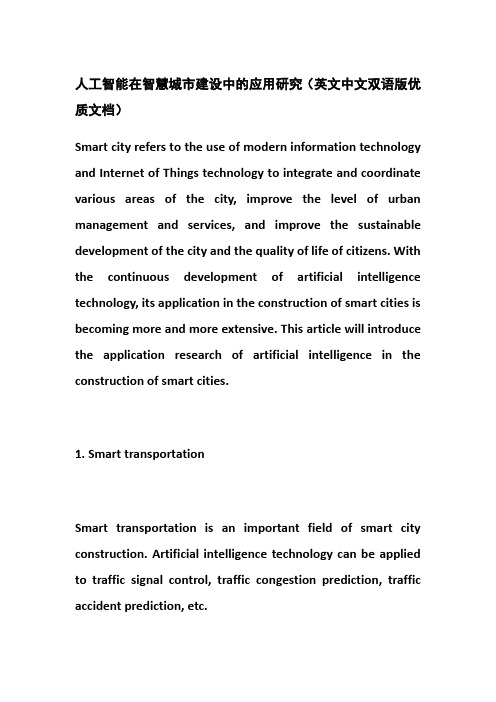
人工智能在智慧城市建设中的应用研究(英文中文双语版优质文档)Smart city refers to the use of modern information technology and Internet of Things technology to integrate and coordinate various areas of the city, improve the level of urban management and services, and improve the sustainable development of the city and the quality of life of citizens. With the continuous development of artificial intelligence technology, its application in the construction of smart cities is becoming more and more extensive. This article will introduce the application research of artificial intelligence in the construction of smart cities.1. Smart transportationSmart transportation is an important field of smart city construction. Artificial intelligence technology can be applied to traffic signal control, traffic congestion prediction, traffic accident prediction, etc.1. Traffic light controlThe traditional traffic signal light control adopts a timing control method, which cannot be adjusted according to the actual traffic situation, and may easily cause traffic jams. The use of artificial intelligence technology can realize intelligent signal light control and intelligent adjustment according to real-time traffic conditions, thereby reducing traffic congestion and improving traffic efficiency.2. Traffic congestion predictionTraffic congestion is a difficult problem in urban traffic management. The use of artificial intelligence technology can predict urban traffic flow and realize traffic congestion prediction. By analyzing traffic flow data, predictive results can be drawn and timely measures can be taken to alleviate congestion.3. Traffic Accident PredictionTraffic accident is a difficult problem in urban traffic management. The use of artificial intelligence technology can predict urban traffic accidents. By analyzing traffic accident data, prediction results can be obtained, and timely measures can be taken to reduce the occurrence of traffic accidents.2. Smart environmental protectionSmart environmental protection is an important field of smart city construction. Artificial intelligence technology can be applied to environmental pollution monitoring, environmental risk assessment and other aspects.1. Environmental pollution monitoringThe use of artificial intelligence technology can realize intelligent environmental pollution monitoring. By collecting environmental pollution data and analyzing and processing, real-time monitoring of environmental pollution can be realized, so as to take timely measures to alleviate environmental pollution.2. Environmental risk assessmentThe use of artificial intelligence technology can achieve intelligent environmental risk assessment. By collecting and analyzing environmental data, the environmental risks can be assessed and measures can be taken in time to reduce the occurrence of environmental risks.3. Smart governanceSmart governance is an important area of smart city construction. Artificial intelligence technology can be applied to urban safety monitoring, social management and other aspects.1. Urban Safety MonitoringUsing artificial intelligence technology can realize smart city safety monitoring. By collecting urban security data and analyzing and processing, real-time monitoring of urban security conditions can be realized, so that measures can be taken in time to ensure the safety of citizens.2. Social managementThe adoption of artificial intelligence technology can realize intelligent social management. By collecting and analyzing social data, it is possible to discover and solve social problems, thereby promoting social harmony and stability.4. Smart medical careSmart healthcare is an important area of smart city construction. Artificial intelligence technology can be applied to disease prediction, medical resource management and other aspects.1. Disease predictionUsing artificial intelligence technology can realize intelligent disease prediction. By collecting and analyzing the patient's data, it is possible to predict the patient's future disease condition and take timely measures to prevent and treat the disease.2. Medical resource managementintelligent medical resource management. By collecting and analyzing medical data, the allocation and scheduling of medical resources can be realized, thereby improving the utilization efficiency of medical resources.5. Wisdom educationSmart education is an important field of smart city construction. Artificial intelligence technology can be applied to educational resource management, teaching quality assessment, etc.1. Educational resource managementintelligent educational resource management. By collecting and analyzing educational data, the allocation and scheduling of educational resources can be realized, thereby improving the utilization efficiency of educational resources.2. Evaluation of Teaching QualityThe use of artificial intelligence technology can realize intelligent teaching quality assessment. By collecting and analyzing the learning data of students, the quality of teaching can be evaluated, so that timely measures can be taken to optimize the teaching method and improve the learning effect of students.6. Smart transportationSmart transportation is an important field of smart city construction. Artificial intelligence technology can be applied to traffic flow management, traffic accident prediction, etc.1. Traffic flow managementIntelligent traffic flow management can be realized by using artificial intelligence technology. By collecting and analyzing traffic data, the traffic flow can be monitored in real time, so as to optimize road traffic planning and reduce congestion.2. Traffic Accident PredictionUsing artificial intelligence technology can realize intelligent traffic accident prediction. By collecting and analyzing traffic data, the probability of traffic accidents can be predicted, and measures can be taken to avoid traffic accidents and ensure driving safety.7. Smart tourismSmart tourism is an important field of smart city construction. Artificial intelligence technology can be applied to tourism services, tourism safety and other aspects.1. Travel servicesThe use of artificial intelligence technology can realize intelligent tourism services. By collecting and analyzing tourism data, it can provide tourists with personalized travel routes, scenic spot recommendations, catering and accommodation services.2. Travel safetyThe use of artificial intelligence technology can realize intelligent tourism safety. By collecting tourism data and analyzing and processing it, it is possible to predict the safety of tourism and provide safety tips and early warnings to ensure the safety of tourists.In general, artificial intelligence technology has a wide range of applications in the construction of smart cities, which can help cities realize intelligent management and optimize resource utilization efficiency, thereby improving the quality of life and development level of cities.智慧城市是指运用现代信息技术和物联网技术,将城市各个领域进行整合和协同,提高城市管理和服务的水平,以提升城市的可持续发展和市民的生活品质。
如何建设智慧城市的英语作文20字
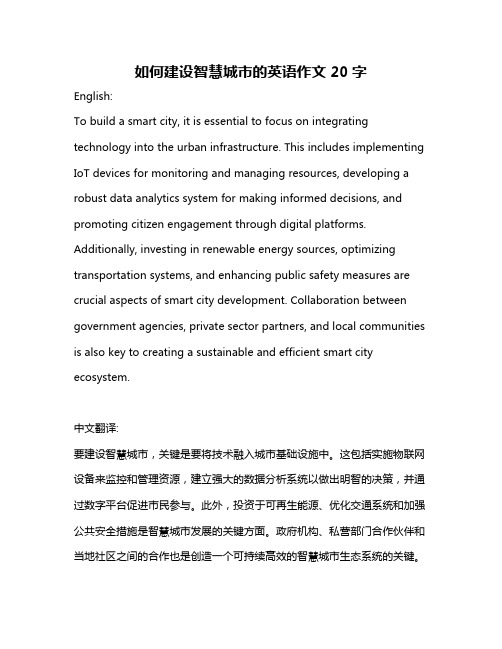
如何建设智慧城市的英语作文20字English:To build a smart city, it is essential to focus on integrating technology into the urban infrastructure. This includes implementing IoT devices for monitoring and managing resources, developing a robust data analytics system for making informed decisions, and promoting citizen engagement through digital platforms. Additionally, investing in renewable energy sources, optimizing transportation systems, and enhancing public safety measures are crucial aspects of smart city development. Collaboration between government agencies, private sector partners, and local communities is also key to creating a sustainable and efficient smart city ecosystem.中文翻译:要建设智慧城市,关键是要将技术融入城市基础设施中。
这包括实施物联网设备来监控和管理资源,建立强大的数据分析系统以做出明智的决策,并通过数字平台促进市民参与。
此外,投资于可再生能源、优化交通系统和加强公共安全措施是智慧城市发展的关键方面。
政府机构、私营部门合作伙伴和当地社区之间的合作也是创造一个可持续高效的智慧城市生态系统的关键。
关于智慧城市可持续发展的英语作文
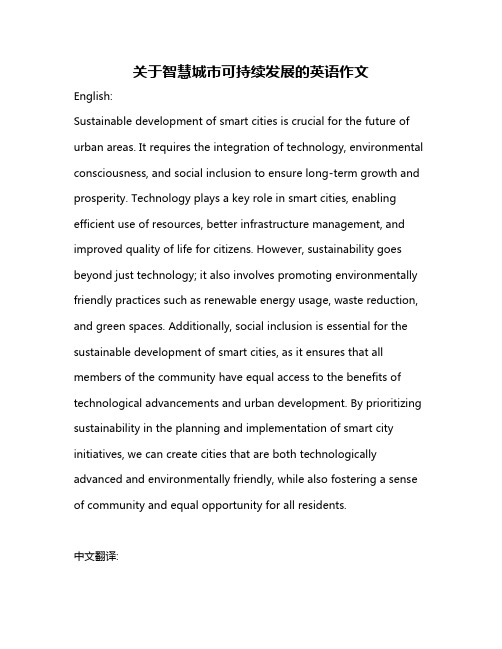
关于智慧城市可持续发展的英语作文English:Sustainable development of smart cities is crucial for the future of urban areas. It requires the integration of technology, environmental consciousness, and social inclusion to ensure long-term growth and prosperity. Technology plays a key role in smart cities, enabling efficient use of resources, better infrastructure management, and improved quality of life for citizens. However, sustainability goes beyond just technology; it also involves promoting environmentally friendly practices such as renewable energy usage, waste reduction, and green spaces. Additionally, social inclusion is essential for the sustainable development of smart cities, as it ensures that all members of the community have equal access to the benefits of technological advancements and urban development. By prioritizing sustainability in the planning and implementation of smart city initiatives, we can create cities that are both technologically advanced and environmentally friendly, while also fostering a sense of community and equal opportunity for all residents.中文翻译:智慧城市的可持续发展对城市地区的未来至关重要。
外文文献翻译智慧城市技术基础及应用
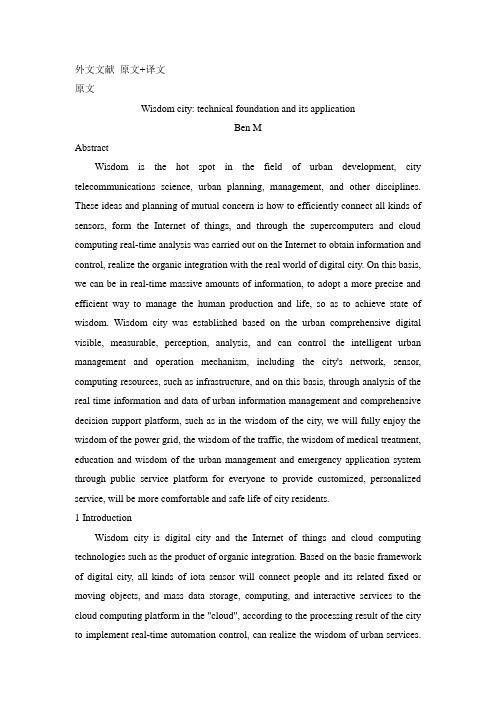
外文文献原文+译文原文Wisdom city: technical foundation and its applicationBen MAbstractWisdom is the hot spot in the field of urban development, city telecommunications science, urban planning, management, and other disciplines. These ideas and planning of mutual concern is how to efficiently connect all kinds of sensors, form the Internet of things, and through the supercomputers and cloud computing real-time analysis was carried out on the Internet to obtain information and control, realize the organic integration with the real world of digital city. On this basis, we can be in real-time massive amounts of information, to adopt a more precise and efficient way to manage the human production and life, so as to achieve state of wisdom. Wisdom city was established based on the urban comprehensive digital visible, measurable, perception, analysis, and can control the intelligent urban management and operation mechanism, including the city's network, sensor, computing resources, such as infrastructure, and on this basis, through analysis of the real time information and data of urban information management and comprehensive decision support platform, such as in the wisdom of the city, we will fully enjoy the wisdom of the power grid, the wisdom of the traffic, the wisdom of medical treatment, education and wisdom of the urban management and emergency application system through public service platform for everyone to provide customized, personalized service, will be more comfortable and safe life of city residents.1 IntroductionWisdom city is digital city and the Internet of things and cloud computing technologies such as the product of organic integration. Based on the basic framework of digital city, all kinds of iota sensor will connect people and its related fixed or moving objects, and mass data storage, computing, and interactive services to the cloud computing platform in the "cloud", according to the processing result of the city to implement real-time automation control, can realize the wisdom of urban services.Digital city will distribution in different areas and different geographical position of economy, culture, transportation, energy and education resources, according to specification of geographic coordinates for wisdom provides a basic framework of digital city. On the basis of digital frame, with RFID, infrared sensors, global positioning system (GPS), information acquisition technology such as laser scanner or sensing device, according to the contract agreement will object to connect to the Internet, in order to achieve the management object of distribution in urban intelligent identification, location, tracking and monitoring services. However, vast amounts of material information management needs cannot rely on computing resources to meet the existing terminal, urgent need scalable computing resources and can dynamically adjust the cloud computing model to solve the massive amounts of data, updating and real-time requirements of very high computational problems, such as the city's road network data real-time calculation and prediction. Based on the digital city organically mix the basic framework of the Internet of things and cloud computing technology. All IP network architecture of Internet of things is an intelligent sensor network, intelligent control network, the characteristics of intelligent safety net at an organic whole, truly identification, location, tracking and monitoring and intelligent management. Through the Internet of things people can be interested in any of the object for perception and operation. The Internet of things is unified coding system, intelligent sensor network, and network system, etc. Unified coding system is through the object type of objects for information such as the only address code and distribution. Intelligent sensor network is a iota of data acquisition and monitoring system of object, it use a variety of instruments and equipment to realize automatic recognition of static or moving objects, and carries on the data collection and exchange. Network system is composed of various local network and global Internet, information flow and management functions. Network system is on the basis of the global Internet, by including object name resolution services and entity markup language, such as software system implement physical interconnection in the city. All kinds of sensors to collect real-time massive amounts of data in digital city, and these huge amounts of data cannot be directly for the use of machines and people, must bethrough a variety of algorithm and model analysis and processing, processing for the available information and knowledge, can produce value finally. Vast amounts of data needs to be updated in real time, the traditional calculation methods cannot meet the need, and highly flexible, scalable, virtualization of cloud computing for complex real-time analysis and processing of all kinds of city model provides the possibility. According to the need of computing power and time requirements, "cloud" can provide elastic matching of computing resources and storage resources, the equivalent of a computing power is almost infinite expansion of the brain, according to the requirements on time will be huge amounts of data into information and knowledge, to provide need machine and user.2 Technical foundations2.1 Digital city related technologiesConcept of "digital city", as is the result of former U.S. vice President al gore presented "digital earth" mentioned in the digital virtual earth scenario. Through technology integration, can make its better integrated into the Internet, to provide services for mankind. The digital city as one of the most important part of digital earth is becoming a hot spot of research and application of digital. Specifically, the digital city is a city to cover the entire again according to the geographic coordinates to facilitate human understanding by the retrieval and utilization. Digital city can be understood as we live in a city in a copy in the digital world, it includes all the digital city related information, physics and chemistry, and visualization. Digital city according to the forms can be divided into the information provided in the form of text, a two-dimensional digital city plane (including 2D map and remote sensing image of city, etc.), 3D digital city space, four-dimensional space-time digital city space. Digital city technology covers the city space information acquisition, management, use, etc., the specific requirements to the construction of digital city and promotes the related technology development and mature gradually. In the future, government, research institutions, standards organizations, non-profit organizations, enterprises will jointly promote the further development and improvement of digital city technology. Seamless information model, all kinds of information scatteredthroughout the city, according to the city's geographic coordinates to reflect the city's natural, cultural, social and other kinds of information.2.2 The Internet of things technology"Internet of things" concept in 1999, the original is defined as "all items by radio frequency identification information such as sensing devices connected to the Internet, to realize intelligent identification and management". On November 17, 2005, "the world summit on information society" in Tunisia, the International Telecommunication Union (International Telecommunication Union, ITU) released the "ITU Internet report 2005: the Internet of things", puts forward the concept of "Internet of things". The definition of the Internet of things is: through the radio frequency identification, infrared sensors, global positioning system (GPS), such as the laser scanner information sensing device, according to the contract agreement, connect any item with the Internet, information exchange and communication, in order to realize intelligent identification, location, tracking and monitoring and management of a network.2.3 Cloud computing technologyCloud computing is a kind of calculation based on the pattern of the Internet, is the further extension and development of distributed computing and grid computing, is as the changes of the Internet resource allocation gradually formed. Computer interaction services once failed to out of the shackles of the hardware and until based on virtualization of the cloud computing, software and interactive services in order to completely has nothing to do with hardware, at the same time, also need not care about the hardware maintenance. Support the information service socialization, intensification and specialized cloud computing center through software reuse and the flexible restructuring, service process optimization and reconstruction, improve the utilization rate. Cloud computing promoted the software resources, information sharing and collaborative work between, forming a service-oriented computing. Cloud computing can be rapid processing huge amounts of data from the world, and provide services to tens of millions of users at the same time. Cloud computing key technology enables users don't need to care about the operating system, database andsoftware environment, and the underlying hardware environment, the computing center location, software providers and service channel. Like electricity, convenient, cloud computing allows users to more naturally and quickly use personalized interaction services.3 The application of wisdom city3.1 Contribute to the sustainable development of urban economyWisdom city construction, in the long run, can bring economic sustainable development and long-term prosperity good benefits. In the short term, can stimulate the digital city, the development of the Internet of things and cloud computing industry. Wisdom city construction, first of all, needs a lot of investment, smart grid, intelligent building, and intelligent transportation infrastructure. It can stimulate the economic growth of the industry, more and create a lot of jobs. Second, will provide more variety for all city residents and more convenient services, like urban operation "lubricant" and "catalyst", will greatly improve the efficiency of society, let everybody can have more effective time, create greater value and wealth. Finally, its infrastructure will for future innovation and industry upgrading transformation of great might.3.2 Service for urban residentsThe existing urban traffic management is basic spontaneously, each driver according to your own judgment to choose the route, traffic signals and signs only have static, limited guidance. That lead to urban road resources failed to get the highest efficiency, and create unnecessary traffic congestion and even paralysis. And relies on wisdom city traffic infrastructure of the sensor, can be the city's traffic, road conditions and other information collected in real time, and through the cloud computing center dynamically calculated the optimal route of traffic control scheme and garage, and then improve the efficiency of traffic system. In addition, after the establishment of a wisdom city infrastructure, both indoors and outdoors, using a laptop or smart handheld devices, can retrieve the user want to various services through the Internet of things, no matter in the office or in another city hotel, or waiting at the airport, can at any time with the team collaborative office, with hisfamily to share the information in the journey, let every urban residents can enjoy the wisdom of the city and convenient services anytime and anywhere.3.3 City security servicesWisdom city will greatly improve the urban security, after onset of events disposition will be engaged in passive receiving alarm disposal into the scene even before the automatic alarm or warning in time. Wisdom city security services to urban public security resources as the carrier, based on a spatial information, business information sharing platform and sensor network, construction of urban daily management, emergency command, prevention, early warning of the trinity of safety protection system, to realize intelligent daily safety management, sensor, automatic alarm warning, rapid response and intelligent aided decision, etc. Intelligent video analysis system can, for example, based on the function of video content analysis, presupposition is different in different video acquisition sensor alarm rules, once the target in the scene appeared a violation of the predefined rules, the system will automatically alarm and relevant personnel may adopt relevant measures from the alarm information.文献出处:Ben M. Wisdom city: technical foundation and its application [J]. Urban Design International, 2016, 4(3): 22-35.译文智慧城市:技术基础及应用Ben M摘要智慧城市是当今城市发展领域关注的热点,涉及电信科学、城市规划、管理学等多个学科门类。
构想中的智慧城市的英文描绘与探讨
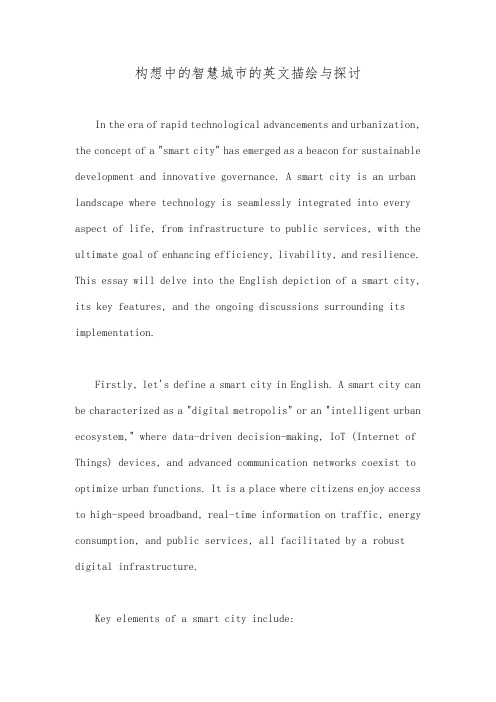
构想中的智慧城市的英文描绘与探讨In the era of rapid technological advancements and urbanization, the concept of a "smart city" has emerged as a beacon for sustainable development and innovative governance. A smart city is an urban landscape where technology is seamlessly integrated into every aspect of life, from infrastructure to public services, with the ultimate goal of enhancing efficiency, livability, and resilience. This essay will delve into the English depiction of a smart city, its key features, and the ongoing discussions surrounding its implementation.Firstly, let's define a smart city in English. A smart city can be characterized as a "digital metropolis" or an "intelligent urban ecosystem," where data-driven decision-making, IoT (Internet of Things) devices, and advanced communication networks coexist to optimize urban functions. It is a place where citizens enjoy access to high-speed broadband, real-time information on traffic, energy consumption, and public services, all facilitated by a robust digital infrastructure.Key elements of a smart city include:1. Connected Infrastructure: Seamless integration of physical and digital systems, such as smart grids, traffic management systems, and waste management, enabling efficient resource allocation.2. Data-Driven Governance: Utilizing big data analytics to inform policy decisions and improve urban planning.3. Inclusive Services: Ensuring universal access to digital services, including healthcare, education, and public safety.4. Green Initiatives: Embracing renewable energy sources and sustainable practices to minimize environmental impact.5. Community Engagement: Encouraging citizen participation through digital platforms, fostering a sense of ownership and well-being.The discourse around smart cities, however, is not without its challenges and concerns. Critics argue that these technologies may exacerbate social inequalities if access to digital services is limited, leading to a digital divide. Privacy concerns also arise as cities collect vast amounts of personal data. Moreover, there is a need to balance the benefits of automation with the potential loss of jobs due to technological disruption.In China, for instance, cities like Hangzhou and Shenzhen have spearheaded the development of smart city initiatives, implementing cutting-edge technologies such as facial recognition systems, mobile payment platforms, and smart transportation. While these projects demonstrate the potential of smart cities, they also highlight the importance of addressing ethical and privacy issues.To ensure a successful transition to a smart city, governments must prioritize collaboration between public and private sectors, engage citizens in the planning process, and invest in education and skills training. International partnerships and knowledge sharing can facilitate best practices and address global challenges.In conclusion, a smart city is an ambitious vision that promises to revolutionize urban living. Its English depiction as a "digital metropolis" captures the essence of interconnected systems and data-driven decision-making. However, it is crucial to navigate the complexities of implementation, ensuring inclusivity, privacy, and sustainability. As we continue to envision and build smarter cities, the global discourse must focus on responsible innovation that empowers citizens and addresses the evolving needs of urbansocieties.智慧城市在中文中的描绘可以概括为“数字之城”或“智能生态城市”,它将信息技术无缝融入城市生活的各个方面,以提升效率、宜居性和韧性。
智慧城市英语作文案例

智慧城市英语作文案例English: A smart city is a city that uses technology and data to improve the quality of life for its residents. By utilizing digital solutions such as sensors, cameras, and connectivity, smart cities can optimize resources, reduce traffic congestion, improve public safety, and enhance overall efficiency. For example, smart traffic lights can adjust their timing based on real-time traffic flow, leading to less congestion and reduced emissions. Additionally, smart waste management systems can track garbage levels in bins and optimize collection routes, leading to a cleaner and more sustainable environment. Furthermore, smart city initiatives often involve citizen engagement platforms that enable residents to provide feedback, report issues, and participate in decision-making processes, ultimately fostering a more inclusive and transparent community. In conclusion, smart cities represent the future of urban development, as they harness the power of technology to create a more livable, sustainable, and connected environment for all.中文翻译: 智慧城市是利用技术和数据提升居民生活质量的城市。
英语作文-物联网技术在智慧城市建设中的应用前景分析
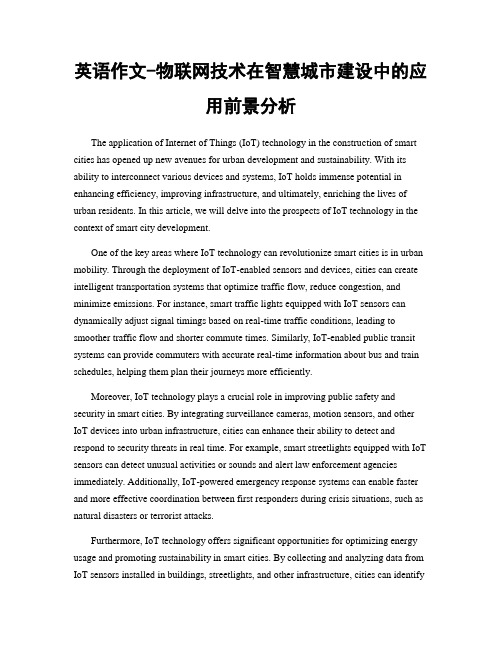
英语作文-物联网技术在智慧城市建设中的应用前景分析The application of Internet of Things (IoT) technology in the construction of smart cities has opened up new avenues for urban development and sustainability. With its ability to interconnect various devices and systems, IoT holds immense potential in enhancing efficiency, improving infrastructure, and ultimately, enriching the lives of urban residents. In this article, we will delve into the prospects of IoT technology in the context of smart city development.One of the key areas where IoT technology can revolutionize smart cities is in urban mobility. Through the deployment of IoT-enabled sensors and devices, cities can create intelligent transportation systems that optimize traffic flow, reduce congestion, and minimize emissions. For instance, smart traffic lights equipped with IoT sensors can dynamically adjust signal timings based on real-time traffic conditions, leading to smoother traffic flow and shorter commute times. Similarly, IoT-enabled public transit systems can provide commuters with accurate real-time information about bus and train schedules, helping them plan their journeys more efficiently.Moreover, IoT technology plays a crucial role in improving public safety and security in smart cities. By integrating surveillance cameras, motion sensors, and other IoT devices into urban infrastructure, cities can enhance their ability to detect and respond to security threats in real time. For example, smart streetlights equipped with IoT sensors can detect unusual activities or sounds and alert law enforcement agencies immediately. Additionally, IoT-powered emergency response systems can enable faster and more effective coordination between first responders during crisis situations, such as natural disasters or terrorist attacks.Furthermore, IoT technology offers significant opportunities for optimizing energy usage and promoting sustainability in smart cities. By collecting and analyzing data from IoT sensors installed in buildings, streetlights, and other infrastructure, cities can identifyopportunities for energy efficiency improvements and cost savings. For instance, smart buildings equipped with IoT-enabled energy management systems can automatically adjust heating, cooling, and lighting settings based on occupancy patterns and environmental conditions, thereby reducing energy waste. Similarly, IoT-powered smart grids can enable more efficient distribution of electricity, integrating renewable energy sources such as solar and wind power into the urban energy mix.In addition to improving infrastructure and enhancing quality of life, IoT technology also fosters innovation and economic growth in smart cities. By creating an interconnected ecosystem of devices, data, and services, IoT stimulates the development of new applications and business models across various industries. For example, IoT-enabled healthcare solutions can facilitate remote patient monitoring, personalized treatment plans, and predictive analytics, improving healthcare outcomes and reducing costs. Similarly, IoT-powered agricultural systems can optimize crop yields, conserve water, and minimize environmental impact, contributing to food security and sustainability in urban areas.In conclusion, the application of IoT technology holds immense promise for the future of smart city development. By leveraging the power of connectivity and data analytics, cities can enhance urban mobility, public safety, energy efficiency, and economic prosperity. However, realizing the full potential of IoT requires collaboration between government, industry, and academia to address challenges related to privacy, security, interoperability, and scalability. With concerted efforts and strategic investments, IoT has the potential to transform cities into more livable, resilient, and sustainable environments for generations to come.。
智慧城建设(中英文对照)-无删减范文
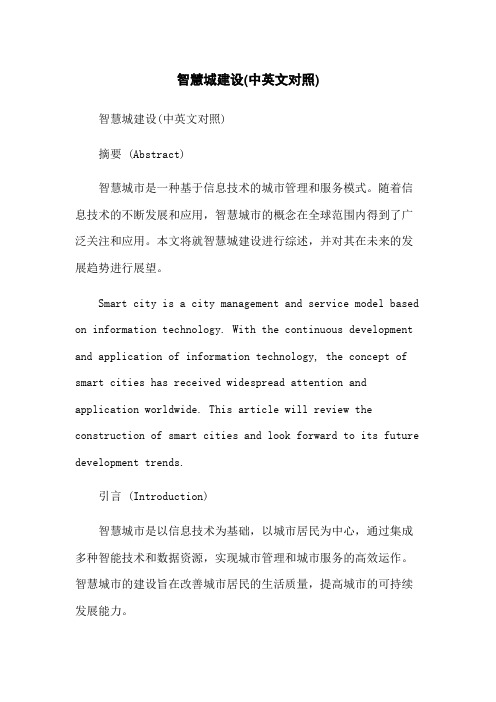
智慧城建设(中英文对照)智慧城建设(中英文对照)摘要 (Abstract)智慧城市是一种基于信息技术的城市管理和服务模式。
随着信息技术的不断发展和应用,智慧城市的概念在全球范围内得到了广泛关注和应用。
本文将就智慧城建设进行综述,并对其在未来的发展趋势进行展望。
Smart city is a city management and service model based on information technology. With the continuous development and application of information technology, the concept of smart cities has received widespread attention and application worldwide. This article will review the construction of smart cities and look forward to its future development trends.引言 (Introduction)智慧城市是以信息技术为基础,以城市居民为中心,通过集成多种智能技术和数据资源,实现城市管理和城市服务的高效运作。
智慧城市的建设旨在改善城市居民的生活质量,提高城市的可持续发展能力。
Smart city is based on information technology, focuses on urban residents, and realizes the efficient operation of urban management and services through the integration of various intelligent technologies and data resources. The construction of smart cities ms to improve the quality of life of urban residents and enhance the sustnable development capability of cities.智慧城建设的关键技术 (Key Technologies for Smart City Construction)1. 物联网技术 (Internet of Things - IoT)物联网技术是智慧城建设的基石,通过各类传感器和物联网设备获取城市的各类数据,并将其传输到中心控制系统进行处理和分析。
智慧城市英语作文案例
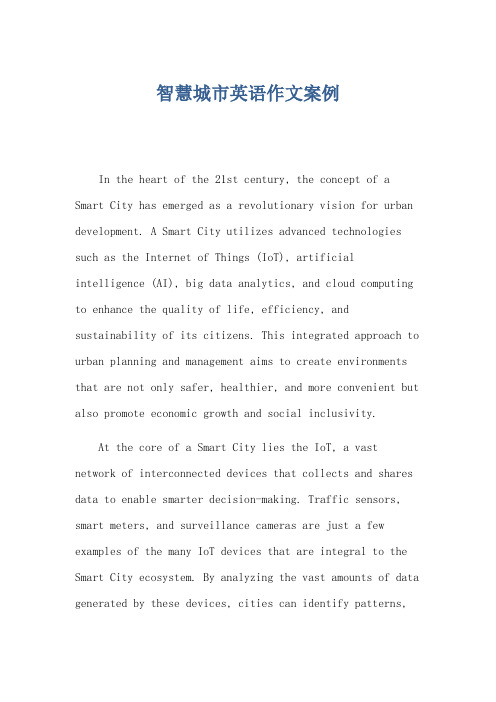
智慧城市英语作文案例In the heart of the 21st century, the concept of a Smart City has emerged as a revolutionary vision for urban development. A Smart City utilizes advanced technologies such as the Internet of Things (IoT), artificial intelligence (AI), big data analytics, and cloud computing to enhance the quality of life, efficiency, and sustainability of its citizens. This integrated approach to urban planning and management aims to create environments that are not only safer, healthier, and more convenient but also promote economic growth and social inclusivity.At the core of a Smart City lies the IoT, a vast network of interconnected devices that collects and shares data to enable smarter decision-making. Traffic sensors, smart meters, and surveillance cameras are just a few examples of the many IoT devices that are integral to the Smart City ecosystem. By analyzing the vast amounts of data generated by these devices, cities can identify patterns,predict outcomes, and respond proactively to issues such as traffic congestion, energy consumption, and crime rates.AI plays a pivotal role in processing and interpreting this data, enabling cities to make intelligent decisions. For instance, AI-powered algorithms can predict the optimal routing for public transportation, reducing travel times and carbon emissions. Similarly, AI-driven health systems can analyze patterns in patient data to identify potential health risks and recommend preventive measures.Big data analytics is another crucial component of a Smart City. By analyzing vast amounts of unstructured data from various sources, cities can gain insights into areas such as citizen behavior, resource utilization, and environmental conditions. These insights can inform policies, improve service delivery, and enhance the overall quality of life.Cloud computing provides the infrastructure necessary to store, process, and analyze this vast amount of data. It enables seamless collaboration between different departments and agencies, improves data accessibility, and ensures scalability as the city grows.In addition to technology, a Smart City also focuses on creating environments that are inclusive and sustainable. This includes providing access to education, healthcare,and other essential services for all citizens, regardlessof their socio-economic status. It also involves adopting green practices and technologies to reduce the city'scarbon footprint and promote environmental sustainability.The benefits of a Smart City are numerous. It can improve traffic flow, reduce congestion, and lower carbon emissions, leading to a more environmentally friendly urban landscape. It can also enhance public safety by enablingreal-time monitoring and response to emergencies. Furthermore, Smart Cities can improve the efficiency of public services, saving time and resources while delivering better outcomes for citizens.However, the transition to a Smart City is not without challenges. It requires significant investment in infrastructure, technology, and human capital. It alsoposes privacy concerns as more data is collected and shared. Therefore, it is crucial to ensure that data privacy andsecurity are prioritized throughout the implementation process.In conclusion, the Smart City represents a vision for the future of urban development. By leveraging advanced technologies and focusing on inclusivity and sustainability, Smart Cities have the potential to transform the lives of their citizens for the better. As we move into the future,it will be essential to continue exploring and innovatingin this space to create cities that are not only smart but also inclusive, sustainable, and resilient.**智慧城市:未来的蓝图**在21世纪的核心地带,智慧城市的概念作为城市发展的革命性愿景而崭露头角。
介绍保定智慧城市150字英语作文
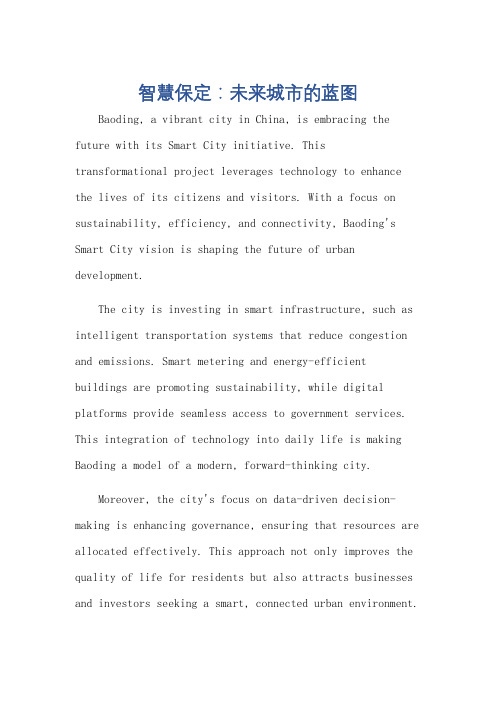
智慧保定:未来城市的蓝图Baoding, a vibrant city in China, is embracing the future with its Smart City initiative. This transformational project leverages technology to enhance the lives of its citizens and visitors. With a focus on sustainability, efficiency, and connectivity, Baoding's Smart City vision is shaping the future of urban development.The city is investing in smart infrastructure, such as intelligent transportation systems that reduce congestion and emissions. Smart metering and energy-efficientbuildings are promoting sustainability, while digital platforms provide seamless access to government services. This integration of technology into daily life is making Baoding a model of a modern, forward-thinking city.Moreover, the city's focus on data-driven decision-making is enhancing governance, ensuring that resources are allocated effectively. This approach not only improves the quality of life for residents but also attracts businesses and investors seeking a smart, connected urban environment.As Baoding's Smart City vision continues to unfold, it offers a glimpse into the future of urbanism - one that is innovative, sustainable, and inclusive. This transformation is not just about technology; it's about creating a citythat works for everyone, ensuring a better tomorrow for all its citizens.**智慧保定:未来城市的蓝图**保定,这座充满活力的中国城市,正通过智慧城市计划拥抱未来。
如何生活在智慧城市英语作文
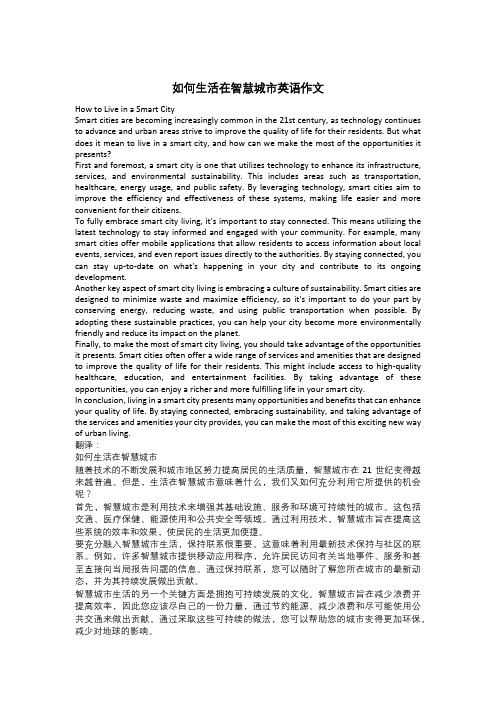
如何生活在智慧城市英语作文How to Live in a Smart CitySmart cities are becoming increasingly common in the 21st century, as technology continues to advance and urban areas strive to improve the quality of life for their residents. But what does it mean to live in a smart city, and how can we make the most of the opportunities it presents?First and foremost, a smart city is one that utilizes technology to enhance its infrastructure, services, and environmental sustainability. This includes areas such as transportation, healthcare, energy usage, and public safety. By leveraging technology, smart cities aim to improve the efficiency and effectiveness of these systems, making life easier and more convenient for their citizens.To fully embrace smart city living, it's important to stay connected. This means utilizing the latest technology to stay informed and engaged with your community. For example, many smart cities offer mobile applications that allow residents to access information about local events, services, and even report issues directly to the authorities. By staying connected, you can stay up-to-date on what's happening in your city and contribute to its ongoing development.Another key aspect of smart city living is embracing a culture of sustainability. Smart cities are designed to minimize waste and maximize efficiency, so it's important to do your part by conserving energy, reducing waste, and using public transportation when possible. By adopting these sustainable practices, you can help your city become more environmentally friendly and reduce its impact on the planet.Finally, to make the most of smart city living, you should take advantage of the opportunities it presents. Smart cities often offer a wide range of services and amenities that are designed to improve the quality of life for their residents. This might include access to high-quality healthcare, education, and entertainment facilities. By taking advantage of these opportunities, you can enjoy a richer and more fulfilling life in your smart city.In conclusion, living in a smart city presents many opportunities and benefits that can enhance your quality of life. By staying connected, embracing sustainability, and taking advantage of the services and amenities your city provides, you can make the most of this exciting new way of urban living.翻译:如何生活在智慧城市随着技术的不断发展和城市地区努力提高居民的生活质量,智慧城市在21世纪变得越来越普遍。
智能经济与智慧城市外文翻译文献中英文最新
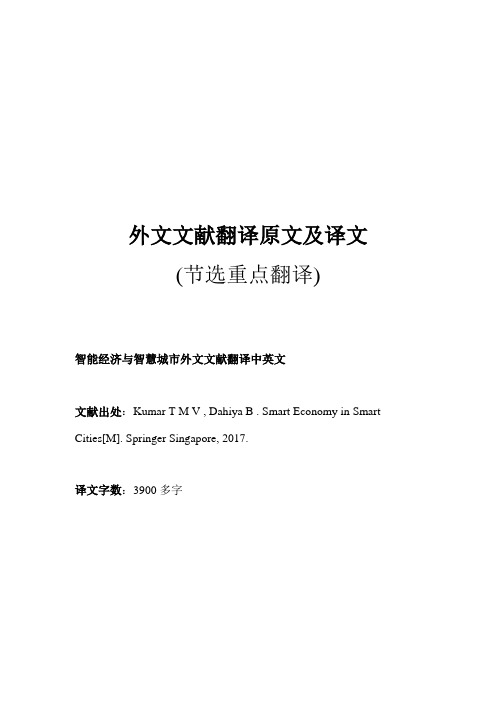
外文文献翻译原文及译文(节选重点翻译)智能经济与智慧城市外文文献翻译中英文文献出处:Kumar T M V , Dahiya B . Smart Economy in Smart Cities[M]. Springer Singapore, 2017.译文字数:3900 多字原文Smart Economy in Smart CitiesT.M. Vinod Kumar and Bharat DahiyaAbstractEmerging patterns of urbanization world over show differing scenarios in different continents, requiring diverse approaches, policies, and strategies. Amazing democratization of ICT around the world leads to a discussion on sustainable, resource-conserving, and resilient smart cities, and smart city economic development appropriate to different cities, countries, and continents. It can be possible that each city in a particular country and continent may possess differing challenges to smart city economic development. When ancient rural economy gives way to urban economy, which contributes a major share of national domestic product, the emerging question is what constitutes smart city economic development. How is it different from conventional urban economy? Is the theory and practice of conventional urban economy valid in a smart city economy or is it necessary to investigate newer theory and practice of smart city economic development? What is a food shed in a smart city economy in smart cities? What a smart city industry looks like? What constitutes smart city commerce services, transportation, and communication, and how they impact on smart city economy? How do smart cities fit in the urban dynamism and policy dialogue at the global,regional, and national levels? Can smart cities and smart economy be socially inclusive? How to strategize social inclusion in smart city development? What sort of governance and institutional support would smart cities require to fulfil their role with regard to smart economy? What may constitute a Sustainable Model of smart cities economic development, and what may be Smart Cities Standards? These are some of the questions addressed in this chapter.Keywords:Urbanizing world,Challenge of smart cities,Smart city system,Smart economyUrbanizing World and the Challenge of Smart Cities‘We live in the times of a global urban transition’ [1]. Historically, cities are considered as the highest forms of economic and sociocultural achievements in human civilization [2], and the location of non-primary economic activities. At present, cities are production centres for goods and services for both internal and external consumption. Cities embody a sense of unique human entrepreneurship, economic dynamism, and evolving multiculturalism—all aided by the incessant technological progress that we see unfolding every day. Today’s city is a high-speed communication hub with strong modern information and communication technologies’ (ICTs) infrastructure that connects the city with cities all over the world in real time. The communication devices are fast evolvingfrom desktop computers to laptop and slate, and now they are moving towards wearable devices, such as mobile phones and other gadgets. Cities function as ‘engines of economic growth’ and dominate local and national economies [3–5]. Cities also act as ‘magnets of hope’ for a vast array of skilled and unskilled people who flock to them to find better livelihoods and lifestyles. Cities are able to perform these multifarious functions as they proclaim to have better infrastructure and services (compared to their rural counterparts), which aids their agglomeration economies and related creative and technology-driven production processes. City dwellers with comparatively higher Human Development Index of tomorrow can only survive if they are on the path of continuous learning, and can become never-exhausting storehouse of superior creativity and innovation to compete with their better-quality products and services around the world. It is due to all these factors that in recent decades cities-led economic growth has featured prominently in the national economic policies of many countries [3–7].What Is a Smart City System?Smart City SystemA Smart City System comprises of six key building blocks: (i) smart people, (ii) smart city economy, (iii) smart mobility, (iv) smart environment, (v) smart living, and (vi) smart governance. These six building blocks are closely interlinked and contribute to the ‘Smart CitySystem’, as illustrated in Fig. 1.4. Some authors treat the six elemen ts of a Smart City System equally [35]. However, following Vinod Kumar [48], we give prominence to ‘smart people’ because without their active participation and involvement a Smart City System would not function in the first place. A Smart City System will risk its efficient functioning without Smart People (more on this in Sect. 1.7).Smart City System—Towards a ManifestoAs urbanization challenges continue to grow and further consolidation of the Information Age takes place around the world, it will become increasingly critical to utilize all possible ways to improve urban living along with social inclusion, economic development, and environmental sustainability. In this regard, it becomes pertinent to think through what constitutes and how to strengthen the various building blocks of a Smart City System. Below, an attempt is made to elaborate the six building blocks that could help develop a manifesto for a Smart City SystemThe Economic Role of CitiesUrbanization, Cities, and Economic GrowthUniversity textbooks often underline the positive correlation between urbanization and economic growth within national economies. Based on the analysis of long-term statistics World Bank [51], UN- Habitat [5] noted that ‘while the share of urban populations worldwideincreased from 33 to 51 % between 1960 and 2010, per capita income increased by 152 %—from US $2382 to US $6006—over the same period’ (p. 43). Backing from such statistics has repeatedly confirmed the notion that urbanization and economic growth go hand in hand [7]. This is especially true when it comes to aggregate figures, such as those highlighted above by UN-Habitat [5]. However, there are exceptions to this. For example, despite slower economic growth compared to other regions, Africa’s urban population grew almost ninefold between 1950 and 2000; some have termed this phenomenon as ‘urbanization without growth’ [52]. Following from the general and positive correlation between urbanization and economic growth, cities are now recognized as engines of economic growth [3–5]. For example, cities in Asia generate over 80 % of national gross domestic product (GDP) [3, 4]. This has led governments to include urbanization as part of national economic development policies, such as in China and India in recent decades.Size of Cities and Economic GrowthCities are abode of prosperity, but their wealth depends on their population size and other factors. Statistics show that the city size matters a great deal in GDP generation of a city in a country. The Economist [53] found that in the USA 164 million people live in 50 major metropolitan areas, while in Europe there are only 102 million inhabitants in metropolitan area. The GDP of European metropolitan areas is of smallersize in comparison with those in the USA. The European metropolitan areas produce 72 % of the GDP of 50 largest cities of the USA. Further, in 31 American states, one or two metropolitan areas account for the vast majority of a state’s economic production, and in 15 other states, a large metropolitan area alone produces most of the GDP [54]. Seventeen major metropolitan areas generate 50 % of the USA’s GDP. An article in The Wall Street Journal [55] explains how US major metropolitan areas produce a higher GDP than the economies of entire nations. Urbanization is also different in terms of city size classes in these two areas. In Europe, 67 % of urban inhabitants live in medium-sized urban centres (i.e. smaller than 500,000 inhabitants), while just 9.6 % are located in cities having more than five million inhabitants. In the USA, one out of five urban inhabitants lives in major cities having more than five million people. Thus, there is a strong indication that population size of a city matters with regard to its urban economy.In 2011, India had 53 metropolitan cities (Fig. 1.5). Large metropolitan cities do have capacity to generate more wealth than smaller ones, as noted above. However, there are no or little data available in India on the GDP contribution of metropolitan (and other) cities. Mumbai and Delhi are two mega-cities in India. Delhi is growing fast and has already become the second largest populated mega-city in the world (after Tokyo). Mumbai generates more tax revenues for India through itsvibrant economy than any other city probably because of its urban economy and population size. Delhi boasts of the highest per capita income in India.It is also being documented in very limited scale that GDP creation of smart cities outpaces several times than of non-smart cities in many countries [36, 56]. These statistics are yet to be known to many.Urbanization and EconomicDevelopment in India Urbanization trend of India is given in Table 1.2. Urban India has grown at an unprecedented rate in the last two decades. A conservative estimate of India’s population growth shows that by 2031 the total population is expected to reach about 1.5 billion, of which the urban population is estimated to be about 600 million, i.e. approximately 40 %. Growth of urban settlements as statutory towns, census towns, and urban agglomeration is shown in Table 1.3. Until lately, it was believed that India lives in its villages. However, Census of India 2011 showed that more population addition took place in urban areas than in rural areas. It can be seen from Table 1.3 that greater number of settlements in India had transformed to Census Towns adding more of urban character to India. Also there is a rapid tendency to form urban agglomeration, and the decadal growth in urban agglomerations stood at 23.7 %. There are also instances in which two adjacent urban agglomerations merge into one big urban agglomeration. During the ten-year period (2001–2011), there was only 6.37 % increase in the number of statutory towns. This shows that in coming years urban agglomeration may become the unit of planning and replace the approach of preparing statutory plans for Municipalities and Municipal Corporations. More and more Metropolitan PlanningCommittees (MPCs), with greater executing capacity, shall be formed for such urban agglomerations in the future. Working population of India is growing as shown below in comparison with a few major economies (Fig. 1.6). China and India contributed maximum numbers of workers to their respective urban economies, and in all likelihood India will surpass China with regard to the number of workers by 2030.Western and industrialized countries already have an urban population near 80 %, while developing countries to date come in at 47 %. Asia and Africa are expected to surpass an urban population of 50 % in 2020 and 2035, respectively. The global urban population is forecasted to increase by 72 % by 2050, growing from 3.6 billion people in 2011 to 6.3 billion in 2050 [11]. By 2020, China’s urban population will reach 60 %, and more than 100 million people will migrate to metropolitan areas or contribute to the creation of new urban centres. It has been observed in time series national statistics that contribution to GDP by urban centres in India is progressively increasing because of high generation of income and employment in cities and towns. Concurrently, the share of GDPcreation in rural centres is diminishing in comparison with that of urban centres. Table 1.4 summarizes the performance of urban economy in India from 1970 to 2005.As can be seen above, urban share of total NDP has grown from 38 % in 1970– 1971 to 52 % in 2004–2005. The NDP share of industry is showing deceleration like agriculture, but there is some acceleration in NDP share of services. Availability of highly skilled workers and investment in skills and higher education as well as opening up industrial development and the ease of starting business can create more urban wealth in urban industries. Time series data and growth of urban share of GDP are shown in the graph (Fig. 1.7). The contribution of urban areas to the national GDP is expected to increase from about 63 % in 2009–2010 to about 75 % in 2030. This 12 % increase in the urban share of GDP in 20 years is only possible with high investment in human resources for industrial skills, urban environment with highly efficient infrastructure—as shown in the benchmarking for smart cities in India (Sect. 1.9.2), and the ease of doing business. This in turn calls for reform in the Indian Administrative Service insisting on timely delivery of regulatory services for establishing new industries. A case in point is the sanction of industrial licenses often gets delayed due to red tape and corruption. In response to this phenomenon, for instance, the State of Telugu Desham (Is this Telangana now or Andhra Pradesh?) came out the policy of rightfor timely sanction of industrial license, and any official responsible for delay will be fined Rs 1000 for every day of delay. This shows signs of extreme dissatisfaction of the elected political leaders with the present administration system in the State of Telugu Desham (Is this Telangana now or Andhra Pradesh?).The estimated increase of 12 % in the urban share of GDP needs to be looked against the targeted growth rate of India as projected by PricewaterhouseCoopers [59] (Table 1.5; Fig. 1.8). It can be seen that if we have to reach 9 % annual growth rate in GDP in the long run, we have to invest in urban centres aimed at creating more smart cities that can act as ‘engines of smart economy’.Urbanization and Urban Economy at Sub-National Level in IndiaAs India is a large country with a big population, it is more meaningful to look at the state and, if possible, at urban agglomeration level. Unfortunately, economic data are not computed for urban agglomerations, but only up to the administrative unit of district, which has little relationship with urban agglomeration boundary. In India, there is wide variation in the level of urbanization of the various states and union territories, as shown in Fig. 1.9. It can be seen that Kerala, Tamil Nadu, Maharashtra, and Gujarat located in the south and west are highly urbanized states along with Manipur in the east. Adjacent to these regions are Karnataka and (old) Andhra Pradesh with slightly lower proportion ofurban population. Other states follow random distribution in the level of urbanization.译文智慧城市的智能经济TM Vinod Kumar, Bharat Dahiya摘要世界各地的新兴城市化模式显示了不同国家的不同情景,需要不同的方法,政策和战略。
智慧城市的基础设施与技术
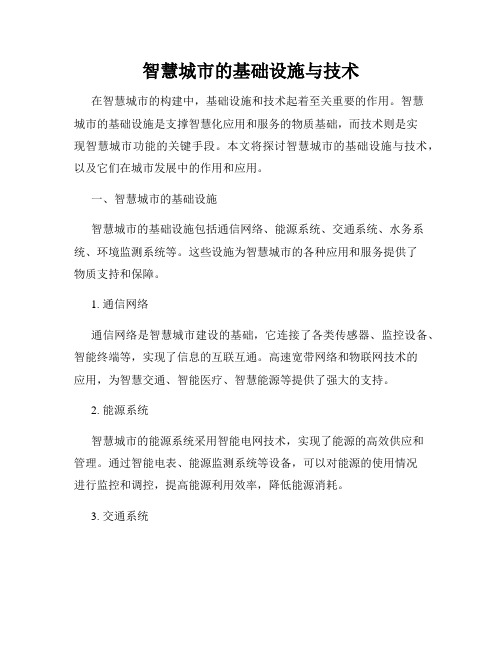
智慧城市的基础设施与技术在智慧城市的构建中,基础设施和技术起着至关重要的作用。
智慧城市的基础设施是支撑智慧化应用和服务的物质基础,而技术则是实现智慧城市功能的关键手段。
本文将探讨智慧城市的基础设施与技术,以及它们在城市发展中的作用和应用。
一、智慧城市的基础设施智慧城市的基础设施包括通信网络、能源系统、交通系统、水务系统、环境监测系统等。
这些设施为智慧城市的各种应用和服务提供了物质支持和保障。
1. 通信网络通信网络是智慧城市建设的基础,它连接了各类传感器、监控设备、智能终端等,实现了信息的互联互通。
高速宽带网络和物联网技术的应用,为智慧交通、智能医疗、智慧能源等提供了强大的支持。
2. 能源系统智慧城市的能源系统采用智能电网技术,实现了能源的高效供应和管理。
通过智能电表、能源监测系统等设备,可以对能源的使用情况进行监控和调控,提高能源利用效率,降低能源消耗。
3. 交通系统智慧城市的交通系统利用智能交通技术,提高了交通管理的效率和安全性。
通过交通控制系统、智能停车系统等设施,可以实现交通拥堵的缓解和交通事故的减少,为居民提供更加便捷的出行方式。
4. 水务系统智慧城市的水务系统利用智能水表、远程监控系统等技术,实现了对水资源的高效利用和管理。
可以实时监测水质和用水情况,提高供水的质量和效率,并对水资源进行合理分配。
5. 环境监测系统智慧城市的环境监测系统通过各类传感器和监测设备,对环境因素进行实时监测和数据采集,如空气质量、噪音、温度等。
通过数据分析和预警,可以及时采取措施,提高环境质量和居民的生活品质。
二、智慧城市的技术支持在智慧城市的建设中,各种前沿技术得到了广泛应用,为城市的发展和改善提供了技术支持和创新动力。
1. 大数据技术大数据技术是智慧城市建设的核心和基础,通过对大规模数据的收集、存储、分析和挖掘,可以从数据中获得有价值的信息和知识,为城市管理和决策提供科学依据。
2. 云计算技术云计算技术为智慧城市的各类应用和服务提供了高效的计算和资源支持。
- 1、下载文档前请自行甄别文档内容的完整性,平台不提供额外的编辑、内容补充、找答案等附加服务。
- 2、"仅部分预览"的文档,不可在线预览部分如存在完整性等问题,可反馈申请退款(可完整预览的文档不适用该条件!)。
- 3、如文档侵犯您的权益,请联系客服反馈,我们会尽快为您处理(人工客服工作时间:9:00-18:30)。
外文文献原文+译文原文Wisdom city: technical foundation and its applicationBen MAbstractWisdom is the hot spot in the field of urban development, city telecommunications science, urban planning, management, and other disciplines. These ideas and planning of mutual concern is how to efficiently connect all kinds of sensors, form the Internet of things, and through the supercomputers and cloud computing real-time analysis was carried out on the Internet to obtain information and control, realize the organic integration with the real world of digital city. On this basis, we can be in real-time massive amounts of information, to adopt a more precise and efficient way to manage the human production and life, so as to achieve state of wisdom. Wisdom city was established based on the urban comprehensive digital visible, measurable, perception, analysis, and can control the intelligent urban management and operation mechanism, including the city's network, sensor, computing resources, such as infrastructure, and on this basis, through analysis of the real time information and data of urban information management and comprehensive decision support platform, such as in the wisdom of the city, we will fully enjoy the wisdom of the power grid, the wisdom of the traffic, the wisdom of medical treatment, education and wisdom of the urban management and emergency application system through public service platform for everyone to provide customized, personalized service, will be more comfortable and safe life of city residents.1 IntroductionWisdom city is digital city and the Internet of things and cloud computing technologies such as the product of organic integration. Based on the basic framework of digital city, all kinds of iota sensor will connect people and its related fixed or moving objects, and mass data storage, computing, and interactive services to the cloud computing platform in the "cloud", according to the processing result of the city to implement real-time automation control, can realize the wisdom of urban services.Digital city will distribution in different areas and different geographical position of economy, culture, transportation, energy and education resources, according to specification of geographic coordinates for wisdom provides a basic framework of digital city. On the basis of digital frame, with RFID, infrared sensors, global positioning system (GPS), information acquisition technology such as laser scanner or sensing device, according to the contract agreement will object to connect to the Internet, in order to achieve the management object of distribution in urban intelligent identification, location, tracking and monitoring services. However, vast amounts of material information management needs cannot rely on computing resources to meet the existing terminal, urgent need scalable computing resources and can dynamically adjust the cloud computing model to solve the massive amounts of data, updating and real-time requirements of very high computational problems, such as the city's road network data real-time calculation and prediction. Based on the digital city organically mix the basic framework of the Internet of things and cloud computing technology. All IP network architecture of Internet of things is an intelligent sensor network, intelligent control network, the characteristics of intelligent safety net at an organic whole, truly identification, location, tracking and monitoring and intelligent management. Through the Internet of things people can be interested in any of the object for perception and operation. The Internet of things is unified coding system, intelligent sensor network, and network system, etc. Unified coding system is through the object type of objects for information such as the only address code and distribution. Intelligent sensor network is a iota of data acquisition and monitoring system of object, it use a variety of instruments and equipment to realize automatic recognition of static or moving objects, and carries on the data collection and exchange. Network system is composed of various local network and global Internet, information flow and management functions. Network system is on the basis of the global Internet, by including object name resolution services and entity markup language, such as software system implement physical interconnection in the city. All kinds of sensors to collect real-time massive amounts of data in digital city, and these huge amounts of data cannot be directly for the use of machines and people, must bethrough a variety of algorithm and model analysis and processing, processing for the available information and knowledge, can produce value finally. Vast amounts of data needs to be updated in real time, the traditional calculation methods cannot meet the need, and highly flexible, scalable, virtualization of cloud computing for complex real-time analysis and processing of all kinds of city model provides the possibility. According to the need of computing power and time requirements, "cloud" can provide elastic matching of computing resources and storage resources, the equivalent of a computing power is almost infinite expansion of the brain, according to the requirements on time will be huge amounts of data into information and knowledge, to provide need machine and user.2 Technical foundations2.1 Digital city related technologiesConcept of "digital city", as is the result of former U.S. vice President al gore presented "digital earth" mentioned in the digital virtual earth scenario. Through technology integration, can make its better integrated into the Internet, to provide services for mankind. The digital city as one of the most important part of digital earth is becoming a hot spot of research and application of digital. Specifically, the digital city is a city to cover the entire again according to the geographic coordinates to facilitate human understanding by the retrieval and utilization. Digital city can be understood as we live in a city in a copy in the digital world, it includes all the digital city related information, physics and chemistry, and visualization. Digital city according to the forms can be divided into the information provided in the form of text, a two-dimensional digital city plane (including 2D map and remote sensing image of city, etc.), 3D digital city space, four-dimensional space-time digital city space. Digital city technology covers the city space information acquisition, management, use, etc., the specific requirements to the construction of digital city and promotes the related technology development and mature gradually. In the future, government, research institutions, standards organizations, non-profit organizations, enterprises will jointly promote the further development and improvement of digital city technology. Seamless information model, all kinds of information scatteredthroughout the city, according to the city's geographic coordinates to reflect the city's natural, cultural, social and other kinds of information.2.2 The Internet of things technology"Internet of things" concept in 1999, the original is defined as "all items by radio frequency identification information such as sensing devices connected to the Internet, to realize intelligent identification and management". On November 17, 2005, "the world summit on information society" in Tunisia, the International Telecommunication Union (International Telecommunication Union, ITU) released the "ITU Internet report 2005: the Internet of things", puts forward the concept of "Internet of things". The definition of the Internet of things is: through the radio frequency identification, infrared sensors, global positioning system (GPS), such as the laser scanner information sensing device, according to the contract agreement, connect any item with the Internet, information exchange and communication, in order to realize intelligent identification, location, tracking and monitoring and management of a network.2.3 Cloud computing technologyCloud computing is a kind of calculation based on the pattern of the Internet, is the further extension and development of distributed computing and grid computing, is as the changes of the Internet resource allocation gradually formed. Computer interaction services once failed to out of the shackles of the hardware and until based on virtualization of the cloud computing, software and interactive services in order to completely has nothing to do with hardware, at the same time, also need not care about the hardware maintenance. Support the information service socialization, intensification and specialized cloud computing center through software reuse and the flexible restructuring, service process optimization and reconstruction, improve the utilization rate. Cloud computing promoted the software resources, information sharing and collaborative work between, forming a service-oriented computing. Cloud computing can be rapid processing huge amounts of data from the world, and provide services to tens of millions of users at the same time. Cloud computing key technology enables users don't need to care about the operating system, database andsoftware environment, and the underlying hardware environment, the computing center location, software providers and service channel. Like electricity, convenient, cloud computing allows users to more naturally and quickly use personalized interaction services.3 The application of wisdom city3.1 Contribute to the sustainable development of urban economyWisdom city construction, in the long run, can bring economic sustainable development and long-term prosperity good benefits. In the short term, can stimulate the digital city, the development of the Internet of things and cloud computing industry. Wisdom city construction, first of all, needs a lot of investment, smart grid, intelligent building, and intelligent transportation infrastructure. It can stimulate the economic growth of the industry, more and create a lot of jobs. Second, will provide more variety for all city residents and more convenient services, like urban operation "lubricant" and "catalyst", will greatly improve the efficiency of society, let everybody can have more effective time, create greater value and wealth. Finally, its infrastructure will for future innovation and industry upgrading transformation of great might.3.2 Service for urban residentsThe existing urban traffic management is basic spontaneously, each driver according to your own judgment to choose the route, traffic signals and signs only have static, limited guidance. That lead to urban road resources failed to get the highest efficiency, and create unnecessary traffic congestion and even paralysis. And relies on wisdom city traffic infrastructure of the sensor, can be the city's traffic, road conditions and other information collected in real time, and through the cloud computing center dynamically calculated the optimal route of traffic control scheme and garage, and then improve the efficiency of traffic system. In addition, after the establishment of a wisdom city infrastructure, both indoors and outdoors, using a laptop or smart handheld devices, can retrieve the user want to various services through the Internet of things, no matter in the office or in another city hotel, or waiting at the airport, can at any time with the team collaborative office, with hisfamily to share the information in the journey, let every urban residents can enjoy the wisdom of the city and convenient services anytime and anywhere.3.3 City security servicesWisdom city will greatly improve the urban security, after onset of events disposition will be engaged in passive receiving alarm disposal into the scene even before the automatic alarm or warning in time. Wisdom city security services to urban public security resources as the carrier, based on a spatial information, business information sharing platform and sensor network, construction of urban daily management, emergency command, prevention, early warning of the trinity of safety protection system, to realize intelligent daily safety management, sensor, automatic alarm warning, rapid response and intelligent aided decision, etc. Intelligent video analysis system can, for example, based on the function of video content analysis, presupposition is different in different video acquisition sensor alarm rules, once the target in the scene appeared a violation of the predefined rules, the system will automatically alarm and relevant personnel may adopt relevant measures from the alarm information.文献出处:Ben M. Wisdom city: technical foundation and its application [J]. Urban Design International, 2016, 4(3): 22-35.译文智慧城市:技术基础及应用Ben M摘要智慧城市是当今城市发展领域关注的热点,涉及电信科学、城市规划、管理学等多个学科门类。
